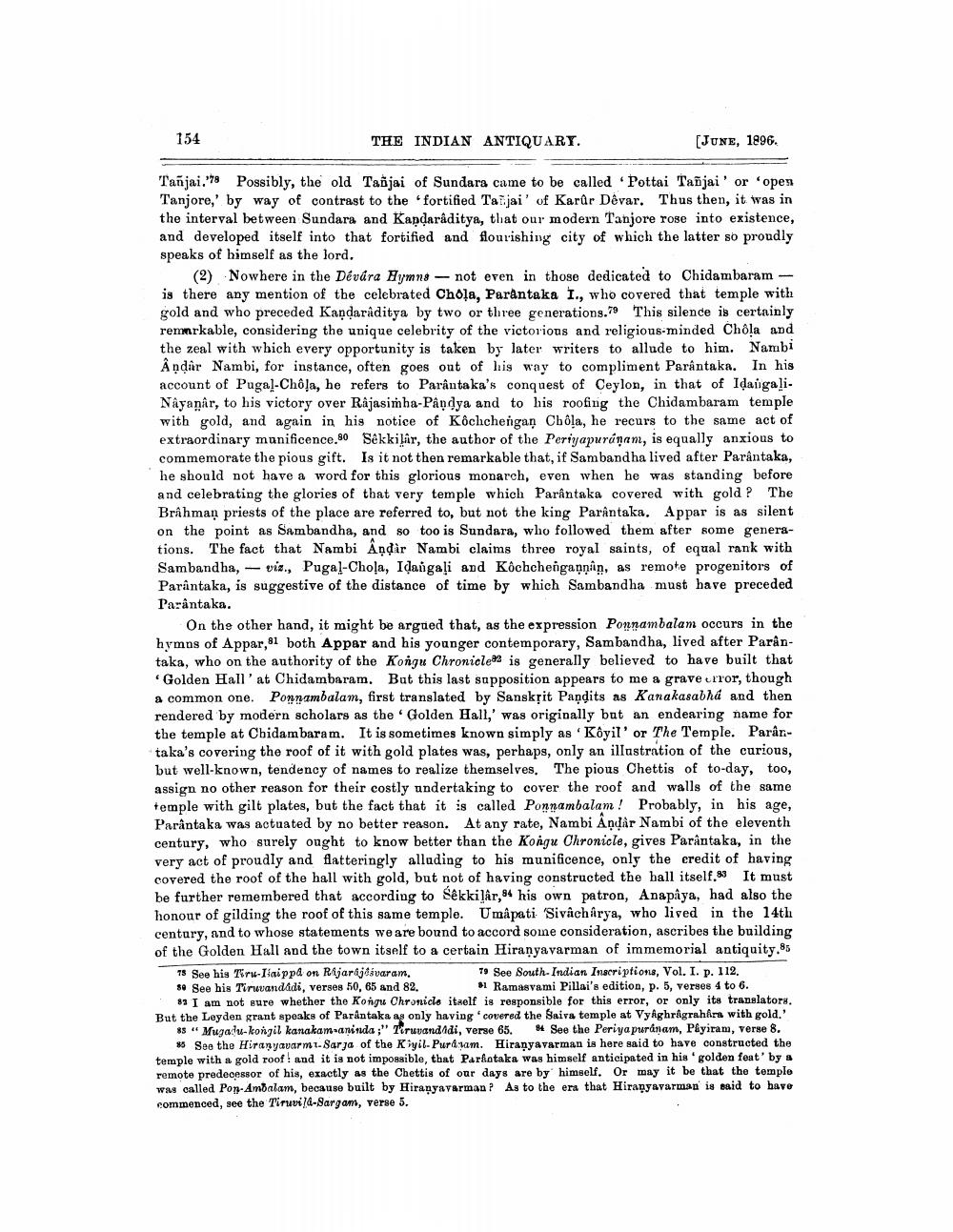________________
154
THE INDIAN ANTIQUARY.
[JUNE, 1896.
Tanjai.'78 Possibly, the old Tagjai of Sundara came to be called Pottai Taõjai' or 'open Tanjore,' by way of contrast to the fortified Talijai' of Karûr Dêvar. Thus then, it was in the interval between Sundara and Kapdaråditya, that our modern Tanjore rose into existence, and developed itself into that fortified and flourishing city of which the latter so proudly speaks of himself as the lord.
(2) Nowhere in the Devara Hymne - not even in those dedicated to Chidambaram - is there any mention of the celebrated Chola, Parantaka I., who covered that temple with gold and who preceded Kaņdarâditya by two or three generations.79 This silence is certainly remarkable, considering the unique celebrity of the victorious and religious-minded Chola and the zeal with which every opportunity is taken by later writers to allude to him. Nambi Ândar Nambi, for instance, often goes ont of his way to compliment Parântaka. In his account of Pugal-Chôļa, he refers to Parântaka's conquest of Ceylon, in that of IdaugaliNayanâr, to his victory over Rajasimha-Pandya and to his roofing the Chidambaram temple with gold, and again in his notice of Kôchchengan Chôla, he recurs to the same act of extraordinary manificence.80 Sekkilir, the author of the Periyapuránan, is equally anxious to commemorate the pious gift. Is it not then remarkable that, if Sambandha lived after Parântaka, he should not have a word for this glorious monarch, even when he was standing before and celebrating the glories of that very temple which Parântaka covered with gold? The Brahman priests of the place are referred to, but not the king Parantaka. Appar is as silent on the point as Sambandha, and so too is Sundara, who followed them after some generations. The fact that Nambi Andir Nambi claims three royal saints, of equal rank with Sambandha, - via, Pugal-Choļa, Idangaļi and Kôchchengannin, as remote progenitors of Parântaka, is suggestive of the distance of time by which Sambandha must have preceded Parantaka.
On the other hand, it might be argued that, as the expression Ponnambalam occurs in the hymns of Appar, 81 both Appar and his younger contemporary, Sambandha, lived after Parântaka, who on the authority of the Kongu Chronicleas is generally believed to have built that Golden Hall'at Chidambaram. But this last sapposition appears to me a grave error, though a common one. Ponnambalam, first translated by Sanskrit Pandits as Kanakasabha and then rendered by modern scholars as the Golden Hall,' was originally but an endearing name for the temple at Chidambaram. It is sometimes known simply as Kôyil' or The Temple. Parântaka's covering the roof of it with gold plates was, perhaps, only an illastration of the curious, but well-known, tendency of names to realize themselves. The pious Chettis of to-day, too, assign no other reason for their costly undertaking to cover the roof and walls of the same temple with gilt plates, but the fact that it is called Ponnambalam! Probably, in his age, Parântaka was actuated by no better reason. At any rate, Nambi Ändar Nambi of the eleventh century, who surely onght to know better than the Kongu Chronicle, gives Parântaka, in the very act of proudly and flatteringly alluding to his munificence, only the credit of having covered the roof of the ball with gold, but not of having constructed the ball itself.93 It must be further remembered that according to Sêkkilar, 94 his own patron, Anapaya, had also the honour of gilding the roof of this same temple. Umâpati Sivacharya, who lived in the 14th century, and to whose statements we are bound to accord some consideration, ascribes the building of the Golden Hall and the town itself to a certain Hiranyavarman of immemorial antiquity.85 75 See his Tiru-Isaippa on Rajarajdávaram.
15 See South Indian Inscriptions, Vol. I. p. 112. 89 See his Tiruvandadi, verses 50, 65 and 82.
1 Ramasvami Pillai's edition, p. 5, verses 4 to 6. I am not sure whether the Kongu Chronicle itself is responsible for this error, or only its translators. But the Leyden grant speaks of Parantaka as only having covered the Saiva temple at Vyhghragrahira with gold.'
88" Mugadu-kongil kanakam-aninda ;" Tiruvand di, verse 65. See the Periya puranam, P&yiram, verse 8.
* See the Hiranyavarm i-Sarja of the KiyilPursam. Hiranyavarman is here said to have constructed the temple with a gold roof! and it is not impossible, that Parlotaka was himself anticipated in his 'golden feat' by a remote predecessor of his, exactly as the Chettis of our days are by himself. Or may it be that the templo was called Pon-Ambalam, because built by Hiranyavarman? As to the era that Hiranyavarman is said to have commenced, see the Tiruvi/8-Sargam, verse 5.




